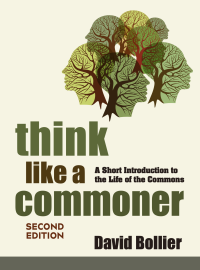Modern economic thought is built upon a narrative for “human nature” that casts us as selfish, materialistic individuals. So what if it could be shown, with some scientific rigor, that human beings are in fact a creature with other vital attributes — that they have successfully survived over millennia by showing keen capacities for trust, empathy, reciprocity and collaboration? That is a key theme in a fascinating new book by John Henry Clippinger, A Crowd of One: The Future of Identity.
John is a friend of mine, and we actually once collaborated on an essay about some of these themes. In his new book, John provides a glorious overview of what evolutionary biology and neuroscience are telling us about how we form our identities — and how these insights can help us build better institutions and policies for learning, conflict-resolution and social development.
In many respects, how we form our identities is a critical ingredient in how we form commons. A commons is not a venue for impersonal transactions, as the market is, but rather a site for actualizing ourselves while manging shared resources. A commons is a social system that integrates our personal needs and identities with a larger community of people. It is a social structure that honors that complex interdependence of individuals and a larger collective.
Drawing upon leading anthropologists, evolutionary scientists and linguists, Clippinger argues that language is an important tool by which we form ourselves into communities. Language enables us to build and leverage trust among members of a group. It is a “signaling system” for describing and enforcing social reputations, which in turn helps us construct social and political institutions. By having a group means of establishing a person’s reputation and identity, we can socially pressure people to live up to consensus standards and expectations. We can also identify “free riders” and cheaters, and punish or ostracize them. These capacities are all critical to forming functional commons.
Clippinger is after big game here: some principles for designing new types of social institutions, especially in this Internet era. He writes:
In contrast to well-entrenched economic and organizational models that operate on the assumption that human beings are selfish, individualistic, rational actors, the new sciences are showing the human beings are also innately cooperative, with highly evolved and highly adaptive strategies of collaboration, trust and reciprocity. By understanding how such innate human social competencies function, it becomes possible to design and implement the next generation of post-Enlightenment institutions.
Clippinger explores, for example, how tagging in online communities can be a tool for creating “social currencies,” which in turn help us build highly efficient and socially convivial communities of shared interest. Just as Renaissance Florence became an economic, artistic and scientific hub of the Enlightenment through the invention of new social roles and reputation systems, so the digital age offers us new opportunities to build new social roles and identities that could unleash a similar renaissance.
Citing eBay and the rating systems of peer networks, Clippinger writes: “Digital technologies offer unprecedented opportunities for amplifying our innate ability to track and manage social relationships by providing virtual methods for assembling, tagging, and rating one another’s behavior, and thereby achieve new forms of visibility, accountability, and hence trust and cooperation.”
One of the more interesting side-themes of A Crowd of One is how military might is fast becoming increasingly archaic and counter-productive in resolving international political conflicts. As the Iraq War is demonstrating, coercion can accomplish only so much. That’s because the real battle is over social meaning and identity. “The ability to define your own identity and that of others is becoming the battleground of the future,” writes Clippinger. “Understanding how narratives, images, and orders are created, legitimized and transmitted through the media and a complex network of tribal relationships can play as important a role in securing a desired military or policy outcome as any sophisticated military maneuver or smart munitions.”
A Crowd of One is frustrating at times because, in prowling the cutting edge of so many disciplines, it raises more questions than can possibly be answered at this time. But that’s also what makes this such a thoughtful, provocative read. It poses new types of questions, and invites us to draw some intriguing connections between realms that are not usually mentioned in the same breath (evolutionary sciencies, digital technology, behavioral economics, the commons).











Recent comments